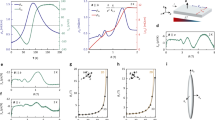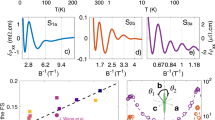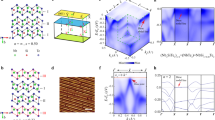Abstract
The discovery of the quantum Hall effect (QHE)1,2 in two-dimensional electronic systems has given topology a central role in condensed matter physics. Although the possibility of generalizing the QHE to three-dimensional (3D) electronic systems3,4 was proposed decades ago, it has not been demonstrated experimentally. Here we report the experimental realization of the 3D QHE in bulk zirconium pentatelluride (ZrTe5) crystals. We perform low-temperature electric-transport measurements on bulk ZrTe5 crystals under a magnetic field and achieve the extreme quantum limit, where only the lowest Landau level is occupied, at relatively low magnetic fields. In this regime, we observe a dissipationless longitudinal resistivity close to zero, accompanied by a well-developed Hall resistivity plateau proportional to half of the Fermi wavelength along the field direction. This response is the signature of the 3D QHE and strongly suggests a Fermi surface instability driven by enhanced interaction effects in the extreme quantum limit. By further increasing the magnetic field, both the longitudinal and Hall resistivity increase considerably and display a metal–insulator transition, which represents another magnetic-field-driven quantum phase transition. Our findings provide experimental evidence of the 3D QHE and a promising platform for further exploration of exotic quantum phases and transitions in 3D systems.
This is a preview of subscription content, access via your institution
Access options
Access Nature and 54 other Nature Portfolio journals
Get Nature+, our best-value online-access subscription
$29.99 / 30 days
cancel any time
Subscribe to this journal
Receive 51 print issues and online access
$199.00 per year
only $3.90 per issue
Buy this article
- Purchase on Springer Link
- Instant access to full article PDF
Prices may be subject to local taxes which are calculated during checkout




Similar content being viewed by others
Data availability
The data that support the findings of this study are available from the corresponding author on request.
References
Klitzing, K. v., Dorda, G. & Pepper, M. New method for high-accuracy determination of the fine-structure constant based on quantized Hall resistance. Phys. Rev. Lett. 45, 494–497 (1980).
Tsui, D. C., Stormer, H. L. & Gossard, A. C. Two-dimensional magnetotransport in the extreme quantum limit. Phys. Rev. Lett. 48, 1559–1562 (1982).
Halperin, B. I. Possible states for a three-dimensional electron gas in a strong magnetic field. Jpn. J. Appl. Phys. 26, 1913–1919 (1987).
Kohmoto, M., Halperin, B. I. & Wu, Y.-S. Diophantine equation for the three-dimensional quantum Hall effect. Phys. Rev. B 45, 13488–13493 (1992).
Bernevig, A., Hughes, T., Raghu, S. & Arovas, D. Theory of the three-dimensional quantum Hall effect in graphite. Phys. Rev. Lett. 99, 146804 (2007).
Störmer, H. L., Eisenstein, J. P., Gossard, A. C., Wiegmann, W. & Baldwin, K. Quantization of the Hall effect in an anisotropic three-dimensional electronic system. Phys. Rev. Lett. 56, 85–88 (1986).
Hannahs, S. T., Brooks, J. S., Kang, W., Chiang, L. Y. & Chaikin, P. M. Quantum Hall effect in a bulk crystal. Phys. Rev. Lett. 63, 1988–1991 (1989).
Cooper, J. R. K., Auban, W., Montambaux, P. & Jérome, G. D. & Bechgaard, K. Quantized Hall effect and a new field-induced phase transition in the organic superconductor (TMTSF)2(PF)6. Phys. Rev. Lett. 63, 1984–1987 (1989).
Hill, S. et al. Bulk quantum Hall effect in η–Mo4O11. Phys. Rev. B 58, 10778–10783 (1998).
Cao, H. et al. Quantized Hall effect and Shubnikov–de Haas oscillations in highly doped Bi2Se3: evidence for layered transport of bulk carriers. Phys. Rev. Lett. 108, 216803 (2012).
Masuda, H. et al. Quantum Hall effect in a bulk antiferromagnet EuMnBi2 with magnetically confined two-dimensional Dirac fermions. Sci. Adv. 2, e1501117 (2016).
Weng, H., Dai, X. & Fang, Z. Transition-metal pentatelluride ZrTe5 and HfTe5: a paradigm for large-gap quantum spin Hall insulators. Phys. Rev. X 4, 011002 (2014).
Jones, T. E., Fuller, W. W., Wieting, T. J. & Levy, F. Thermoelectric power of HfTe5 and ZrTe5. Solid State Commun. 42, 793–798 (1982).
Li, Q. et al. Chiral magnetic effect in ZrTe5. Nat. Phys. 12, 550–554 (2016).
Liang, T. et al. Anomalous Hall effect in ZrTe5. Nat. Phys. 14, 451–455 (2018).
Liu, Y. et al. Zeeman splitting and dynamical mass generation in Dirac semimetal ZrTe5. Nat. Commun. 7, 12516 (2016).
Zheng, G. et al. Transport evidence for the three-dimensional Dirac semimetal phase in ZrTe5. Phys. Rev. B 93, 115414 (2016).
Zhang, Y. et al. Electronic evidence of temperature-induced Lifshitz transition and topological nature in ZrTe5. Nat. Commun. 8, 15512 (2017).
Bardasis, A. & Das Sarma, S. Peierls instability in degenerate semiconductors under strong external magnetic fields. Phys. Rev. B 29, 780–784 (1984).
MacDonald, A. & Bryant, G. Strong-magnetic-field states of the pure electron plasma. Phys. Rev. Lett. 58, 515–518 (1987).
Chen, R. Y. et al. Magnetoinfrared spectroscopy of Landau levels and Zeeman splitting of three-dimensional massless Dirac fermions in ZrTe5. Phys. Rev. Lett. 115, 176404 (2015).
Wilson, J. A., Di Salvo, F. J. & Mahajan, S. Charge-density waves and superlattices in the metallic layered transition metal dichalcogenides. Adv. Phys. 24, 117 (1975).
McMillan, W. L. Theory of discommensurations and the commensurate–incommensurate charge-density-wave phase transition. Phys. Rev. B 14, 1496 (1976).
Lee, P. A. & Rice, T. M. Electric field depinning of charge density waves. Phys. Rev. B 19, 3970 (1979).
Monçeau, P., Ong, N. P., Portis, A. M., Meerschaut, A. & Rouxel, J. Electric field breakdown of charge-density-wave–induced anomalies in NbSe3. Phys. Rev. Lett. 37, 602 (1976).
Andrei, E. et al. Observation of a magnetically induced Wigner solid. Phys. Rev. Lett. 60, 2765–2768 (1988).
Zhang, C., Du, R.-R., Manfra, M. J., Pfeiffer, L. N. & West, K. W. Transport of a sliding Wigner crystal in the four flux composite fermion regime. Phys. Rev. B 92, 075434 (2015).
Yang, K., Haldane, F. D. M. & Rezayi, E. H. Wigner crystals in the lowest Landau level at low-filling factors. Phys. Rev. B 64, 081301 (2001).
Field, S. B., Reich, D. H., Rosenbaum, T. F., Littlewood, P. B. & Nelson, D. A. Electron correlation and disorder in Hg1−xCdxTe in a magnetic field. Phys. Rev. B 38, 1856–1864 (1988).
Shayegan, M., Goldman, V. J. & Drew, H. D. Magnetic-field-induced localization in narrow-gap semiconductors Hg1−xCdxTe and InSb. Phys. Rev. B 38, 5585–5602 (1988).
Acknowledgements
We thank J. Mei, L. Fu, X. Dai, X. Wang, K. T. Law, D. Yu, F. Zhang, J. Wu and D. L. Deng for valuable discussions. This work was supported by the Guangdong Innovative and Entrepreneurial Research Team Program (2016ZT06D348), NNSFC (11874193), the Shenzhen Fundamental Subject Research Program (JCYJ20170817110751776) and the Innovation Commission of Shenzhen Municipality (KQTD2016022619565991). F.T. thanks the Department of Physics, Renmin University of China for visiting student support. Work at the University of Science and Technology of China, was supported by the National Key R&D Program of China (2016YFA0301700), NNSFC (11474265) and Anhui Initiative in Quantum Information Technologies (AHY170000). Work at Brookhaven is supported by the Office of Basic Energy Sciences, US Department of Energy under contract number DE-SC0012704. The work of K.Y. is supported by National Science Foundation grants DMR-1442366 and DMR-1644779. P.A.L. acknowledges support by the US Department of Energy Basic Energy Sciences grant DE-FG02-03-ER46076. S.A.Y. is supported by the Singapore Ministry of Education AcRF Tier 2 (MOE2015-T2-2-144).
Reviewer information
Nature thanks Alberto Crepaldi, Itamar Kimchi and the other anonymous reviewer(s) for their contribution to the peer review of this work.
Author information
Authors and Affiliations
Contributions
F.T. and P.W. carried out the transport measurements. J.S., R.Z. and G.G. prepared the samples. Y.R., S.A.Y., K.Y. and P.A.L. performed the theoretical analysis. Z.Q. and L.Z. designed and supervised the work. All authors contributed to the interpretation and analysis of the data and the writing of the manuscript.
Corresponding authors
Ethics declarations
Competing interests
The authors declare no competing interests.
Additional information
Publisher’s note: Springer Nature remains neutral with regard to jurisdictional claims in published maps and institutional affiliations.
Extended data figures and tables
Extended Data Fig. 1 3D QHE in different samples and temperature dependence of Hall resistivity.
a–c, 3D QHE results for ZrTe5 samples 1 (a), 2 (b) and 4 (c) at T = 1.5 K. d, Hall resistivity of sample 2 at different temperatures ranging from 0.6 K to 20 K. Neighbouring curves are shifted by 5 mΩ cm for clarity.
Extended Data Fig. 2 Angular dependence of Hall resistivity.
a–d, The dependence of the Hall resistivity on angle β (a, c) and angle α (b, d) is shown for ZrTe5 samples 1 (a), 4 (b), 2 (c) and 2 (d).
Extended Data Fig. 3 Signatures of 3D fractional QHE.
a, dρxy/dB and −d2ρxx/dB2 and versus 1/B⊥ at angles β = 0°, 15°, 30°, 60°. The vertical dashed lines indicate the N = 1/3, 1, 2, 3, 4, 5 Landau indices. b, Zoom-in of the extreme-quantum-limit region 0 < N < 1. The N = 1/3 peak can be observed. c, dρxy/dB versus 1/B⊥ at temperatures ranging from 1.5 K to 15 K.
Extended Data Fig. 4 In-plane measurements and quantum oscillations.
Measurement of SdH oscillations in ZrTe5 (sample 4) when a magnetic field is applied in the y direction. a–d, Coherent transport of ρxx (a, c) and ρzz (b, d). a, b, Schematic illustration of the setup with B//y and I//x (a) and with B//y and I//z (b). c, Longitudinal resistivity ρxx and Hall resistivity ρzx measured in the x–z plane, with magnetic field B//y and current I//x. c, d, ρxx and ρzz show similar oscillation patterns. Inset, zoom-in view of ρzz versus B. However, in zero magnetic field, the resistivity ρzz is about 30 times larger than ρxx.
Supplementary information
Supplementary Information
This file contains Supplementary Text and Data, Supplementary Tables 1 and 2, Supplementary Figures 1-22 and Supplementary References – see Contents page for details.
Rights and permissions
About this article
Cite this article
Tang, F., Ren, Y., Wang, P. et al. Three-dimensional quantum Hall effect and metal–insulator transition in ZrTe5. Nature 569, 537–541 (2019). https://doi.org/10.1038/s41586-019-1180-9
Received:
Accepted:
Published:
Issue Date:
DOI: https://doi.org/10.1038/s41586-019-1180-9
This article is cited by
-
Controllable strain-driven topological phase transition and dominant surface-state transport in HfTe5
Nature Communications (2024)
-
Surface potential-adjusted surface states in 3D topological photonic crystals
Scientific Reports (2024)
-
Three-dimensional flat Landau levels in an inhomogeneous acoustic crystal
Nature Communications (2024)
-
Chiral symmetry restoration and the ultraquantum limit of axionic Charge Density Waves in Weyl Semimetals
Journal of High Energy Physics (2024)
-
High-energy photoemission final states beyond the free-electron approximation
Nature Communications (2023)
Comments
By submitting a comment you agree to abide by our Terms and Community Guidelines. If you find something abusive or that does not comply with our terms or guidelines please flag it as inappropriate.



